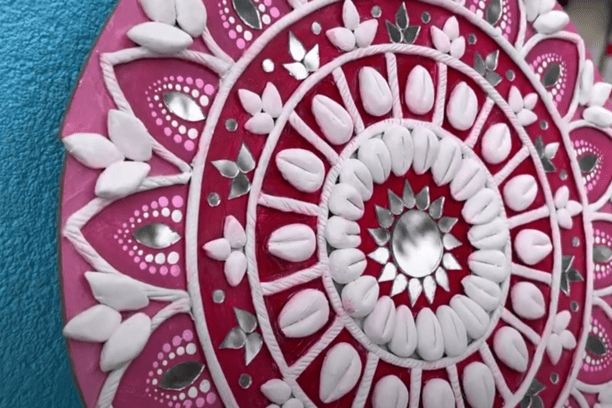What is lippan art ?
Lippan art” refers to a traditional form of mural art that originates from the Kutch region in Gujarat, India. This art form is also known as Mud-Mirror art.
In Lippan art, a mixture of clay and camel dung is used to create a base on walls. Small mirrors are then embedded in this base, forming intricate geometric and floral patterns. The mirrors not only add a decorative element but also reflect light, creating a sparkling effect.
Lippan art is often associated with the traditional mud huts (bhungas) of the Kutch region. The art form is not only aesthetically pleasing but also serves practical purposes, such as regulating the temperature inside the huts.
Here are some key points and ideas associated with Lippan art:
- Geometric and Floral Patterns: Lippan art typically involves creating intricate geometric and floral patterns using a mixture of clay and camel dung on walls.
- Mirror Embellishments: Small mirrors are an essential element of Lippan art. They are embedded in the clay mixture, adding a reflective and sparkling quality to the artwork.
- Traditional Craftsmanship: Lippan art is a traditional folk art form that has been practiced for generations in the Kutch region of Gujarat, India.
- Cultural Significance: Often found in traditional mud huts (bhungas), Lippan art is not only decorative but also serves practical purposes, helping regulate the temperature inside the dwellings.
- Earth-Friendly Materials: The art form uses natural materials such as clay and camel dung, making it eco-friendly and sustainable.
- Symbolism and Meaning: The patterns and motifs in Lippan art may carry cultural or symbolic significance, representing elements of nature, spirituality, or folklore.
- Craftsmanship Technique: Creating Lippan art involves a skilled technique of applying the clay mixture and embedding mirrors in a way that forms visually appealing and balanced designs.
- DIY Lippan Art: Lippan art ideas can be adapted for DIY projects. Enthusiasts can experiment with creating smaller pieces using similar techniques, perhaps on canvases or smaller wall spaces.
- Color Palette: While the traditional form often uses natural earth tones, contemporary adaptations might incorporate a broader color palette to suit different tastes and settings.
- Cultural Workshops and Classes: Some organizations or artists offer workshops or classes to teach Lippan art, helping to preserve and promote this traditional craft.
- Integration with Modern Interiors: Lippan art can be adapted to modern interiors, adding a touch of cultural and artisanal aesthetics to contemporary spaces.
- Community Art Projects: Lippan art can be a collaborative community project, bringing people together to create large-scale murals or installations.
Remember that while these points provide an overview, the creativity and expression in Lippan art can vary widely, and artists often bring their own unique styles and interpretations to the tradition. Register yourself for Art Classes if you are interested. Payment will be collected later when you join the first class. You can refer class and payment policies or reach us for more information.

